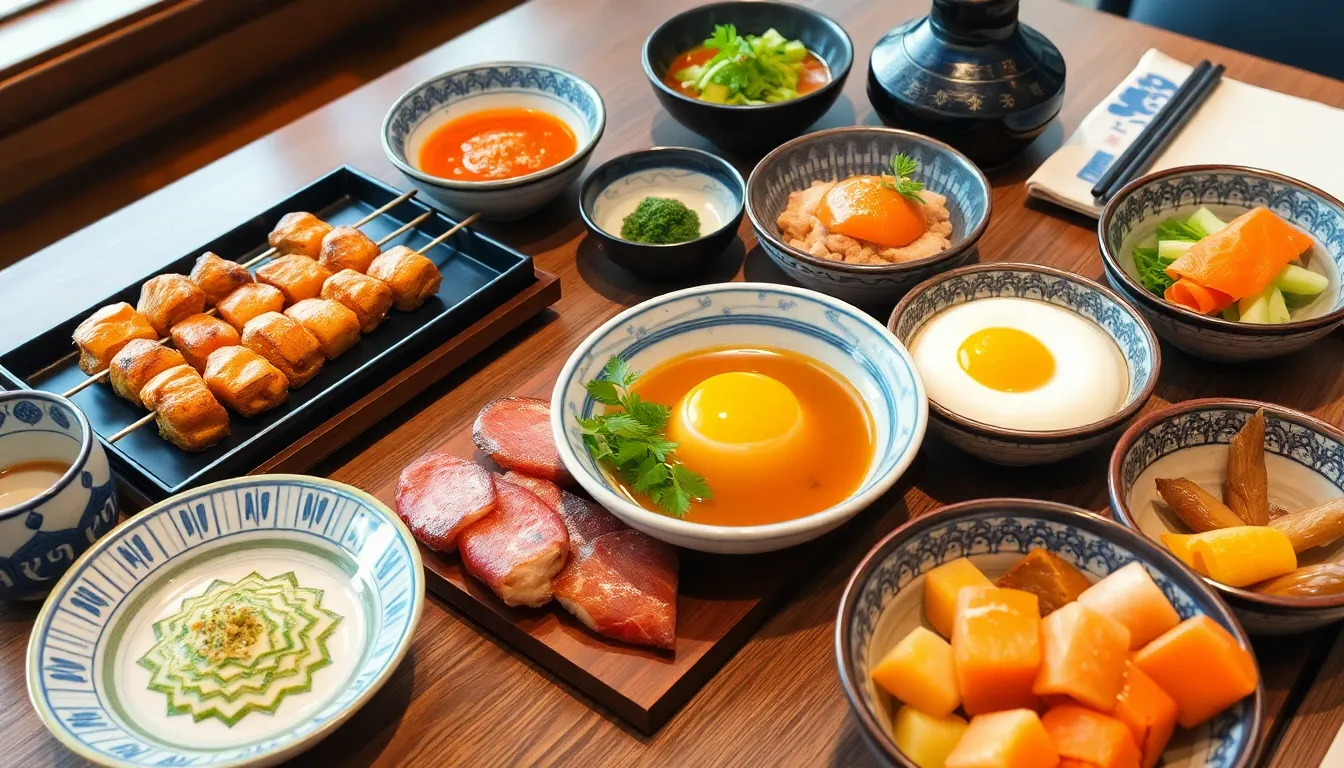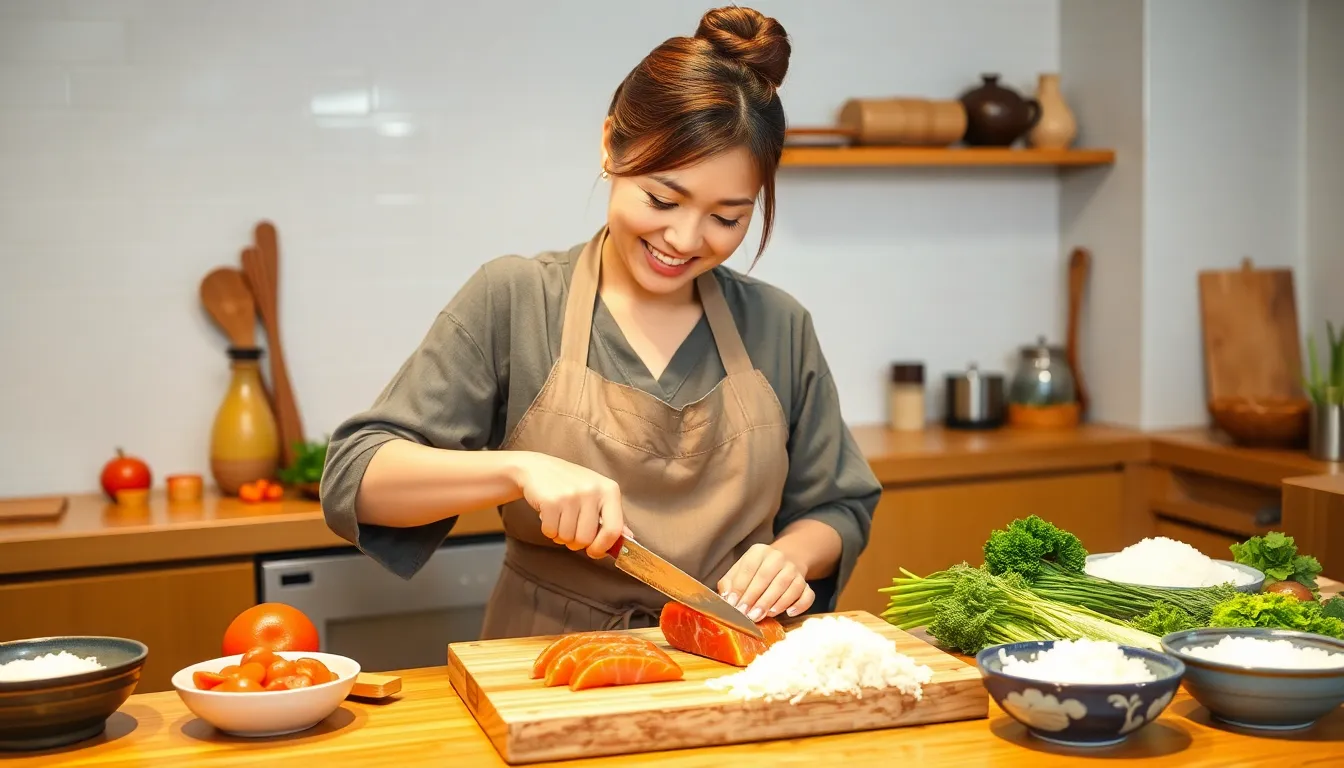Japanese cooking techniques are like a well-kept secret, waiting to transform any home chef into a culinary ninja. From the precision of slicing fish for sashimi to the delicate art of sushi rolling, these methods offer a delightful blend of tradition and innovation. Imagine impressing friends with your newfound skills, all while channeling your inner samurai in the kitchen!
Table of Contents
ToggleOverview Of Japanese Cooking Techniques
Japanese cooking techniques focus on simplicity and elegance. These methods emphasize the quality of ingredients, showcasing their natural flavors. Techniques often involve precision cutting, such as in the preparation of sashimi, where thin slices of fish highlight freshness.
Steaming represents another popular technique, often seen in dishes like chawanmushi. This gentle method retains nutrients and enhances flavors, creating a delicate texture. Simmering, used in dishes such as nimono, allows for gradual flavor development as ingredients meld together.
Grilling, particularly yakitori, emphasizes using high-quality skewered meats and vegetables. The process infuses them with a rich, smoky flavor. Additionally, frying, like in tempura, showcases light batter that crisps up quickly, keeping the main ingredient tender.
Fermentation holds a significant place in Japanese cuisine as well. Foods like miso and soy sauce undergo fermentation to develop deep umami flavors. These fermented ingredients form a foundational element in many traditional dishes.
Pickling adds another layer of depth to Japanese cooking techniques. Tsukemono, or Japanese pickles, enhance textures and flavors, often served as a side dish. Lastly, presentation plays a critical role in Japanese cooking, transforming meals into visual art.
Understanding these techniques enables home chefs to create authentic Japanese dishes. Mastering the balance of flavors and aesthetics within these methods can elevate one’s culinary skills significantly.
Traditional Cooking Methods

Japanese cuisine showcases various traditional cooking methods that enhance flavors and textures. Each technique contributes uniquely to the culinary experience.
Grilling (Yaki)
Grilling infuses dishes with a smoky flavor that enhances the natural taste of ingredients. Yakitori exemplifies this method, where skewered chicken is grilled over charcoal. Marinades and seasonings, such as tare or salt, elevate the taste significantly. Notably, the grill’s high heat caramelizes the exterior while keeping the inside juicy. This technique serves not only meats, but also vegetables. Grilled eggplant and bell peppers highlight the versatility of yaki, appealing to both meat lovers and vegetarians.
Steaming (Mushi)
Steaming offers a gentle cooking method that preserves nutrients and enhances natural flavors. Mushi techniques shine in dishes like chawanmushi, where delicate egg custard is steamed to creamy perfection. The gentle heat allows ingredients like shrimp, ginkgo nuts, and seasonal vegetables to infuse their flavors into the custard. Various steamers, such as bamboo or electronic models, cater to diverse culinary needs. Steamed buns and vegetables showcase this method’s effectiveness, maintaining vibrant colors and textural integrity while highlighting their freshness.
Boiling (Niru)
Boiling serves as a foundational technique in Japanese cooking, emphasizing simplicity and flavor extraction. In nimono dishes, ingredients simmer in dashi or seasoned broth to enhance their essence. Common items include root vegetables, fish, and meats, each absorbing rich flavors over time. The process of boiling softens elements, making them tender and easy to enjoy. Additionally, tsukemono, pickled vegetables, often involve a quick boiling phase to enhance flavor and preservation. This method connects home chefs with the core principles of Japanese cuisine, focusing on balance and harmony.
Modern Techniques
Modern Japanese cooking techniques incorporate innovative methods that enhance flavor and texture while respecting traditional principles.
Sous Vide Cooking
Sous vide cooking allows for precise temperature control, creating tender and flavorful dishes. This method involves sealing food in vacuum bags and immersing them in a water bath at regulated temperatures. Chefs use sous vide for perfectly cooked proteins, achieving consistent results for dishes like chashu pork. Additionally, the low temperature retains moisture and nutrients, elevating the final product’s quality. Time spent in the water bath also infuses flavors, with ingredients melding beautifully. By adopting sous vide, home chefs can explore new culinary horizons while maintaining the integrity of traditional Japanese dishes.
Fusion Approaches
Fusion approaches blend Japanese culinary techniques with global flavors, resulting in exciting new dishes. Many chefs explore combinations like sushi burritos and ramen burgers, merging familiar elements into unique offerings. Techniques such as tempura frying are adapted to incorporate diverse ingredients, creating innovative flavors and textures. Each fusion dish highlights the potential of Japanese methods while introducing a broader culinary context. Embracing fusion encourages experimentation and inspires creativity for home chefs eager to elevate their cooking. This trend celebrates the adaptability of Japanese cuisine while maintaining respect for its rich traditions.
Key Ingredients In Japanese Cooking
Japanese cuisine relies on specific ingredients that define its unique flavors and textures. Central to this culinary tradition are rice and umami, both essential elements.
Importance Of Rice
Rice serves as the foundation of many Japanese meals, symbolizing nourishment and prosperity. Short-grain varieties, such as Japonica, are favored for their sticky texture, which enhances the eating experience. Each meal often features rice, whether served plain or as part of sushi, onigiri, or donburi. Cooking techniques like washing rice and using steam contribute to achieving the perfect consistency. Observing the traditional practice of sushi-making reveals how rice’s vinegar seasoning balances flavors. Emphasizing quality, local rice varieties enhance dishes and reflect the region’s culture.
Role Of Umami
Umami, often called the fifth taste, plays a critical role in Japanese cooking. Ingredients rich in umami, such as miso, soy sauce, and dashi, deepen flavors and add complexity. Fermentation and slow cooking methods release umami compounds, intensifying the taste profile of various dishes. Many chefs prioritize umami when creating recipes, making it a key consideration in ingredient selection. The balance of umami with other tastes like sweetness and saltiness creates harmony in meals. Recognizing umami’s impact elevates the overall dining experience, showcasing the depth of Japanese culinary artistry.
Japanese cooking techniques offer a unique blend of tradition and innovation that can transform any home chef’s culinary journey. By embracing these methods chefs can elevate their dishes while respecting the core principles of balance and harmony. The focus on quality ingredients and the artistry of presentation makes each meal a celebration of flavor and aesthetics.
As chefs experiment with both traditional and modern techniques they unlock endless possibilities in their kitchens. Whether it’s perfecting the art of sushi rolling or exploring the intricacies of umami through fermentation, the journey into Japanese cuisine promises a rewarding experience. This culinary adventure not only enhances skills but also deepens appreciation for the rich heritage behind each dish.




